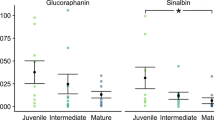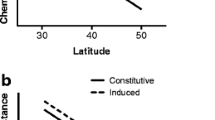Abstract
Plant-induced responses to multiple herbivores can mediate ecological interactions among herbivore species, thereby influencing herbivore community composition in nature. Several studies have indicated high specificity of induced responses to different herbivore species. In addition, there may be genetic variation for plant response specificity that can have significant ecological implications, by altering the competitive strength and hierarchical relationships among interacting herbivore species. However, few studies have examined whether plant populations harbor genetic variation for induction specificity. Using three distinct genotypes of Solidago altissima plants, we examined whether specialist herbivore species Dichomeris leuconotella, Microrhopala vittata, and Trirhabda virgata elicit specific induction responses from plants (specificity of elicitation), and whether induction differentially affects these herbivore species (specificity of effect). Results from bioassays and secondary metabolite analyses suggest that there is specificity of both elicitation and effect in the induced responses: D. leuconotella and M. vittata preferred and performed better on leaves damaged by conspecifics than heterospecifics, and induced qualitatively different secondary metabolite profiles. In contrast, T. virgata equally avoided but physiologically tolerated all types of damage. These patterns of specificity suggest that plant-induced responses mediate asymmetric competitive interactions between herbivore species, which potentially intensifies inter-specific relative to intra-specific competition. Plant genotypes widely differed in overall susceptibility to the herbivores and secondary metabolite production, yet we found no genotype-by-treatment interactions in insect performance, preference and plant secondary metabolite production. This lack of genetic variation for induction specificity suggests that competitive interactions between herbivore species on S. altissima are homogeneous across plant genotypes.




Similar content being viewed by others
References
Adler FR, Karban R (1994) Defended fortresses or moving targets—another model of inducible defenses inspired by military metaphors. Am Nat 144:813–832
Agrawal A (2000) Specificity of induced resistance in wild radish: causes and consequences for two specialist and two generalist caterpillars. Oikos 89:493–500. doi:10.1034/j.1600-0706.2000.890308.x
Amarasekare P (2003) Competitive coexistence in spatially structured environments: a synthesis. Ecol Lett 6:1109–1122. doi:10.1046/j.1461-0248.2003.00530.x
Anderson KE, Inouye BD, Underwood N (2009) Modeling herbivore competition mediated by inducible changes in plant quality. Oikos 118:1633–1646. doi:10.1111/j.1600-0706.2009.17437.x
Ando Y, Ohgushi T (2008) Ant- and plant-mediated indirect effects induced by aphid colonization on herbivorous insects on tall goldenrod. Popul Ecol 50:181–189. doi:10.1007/s10144-007-0072-2
Bernays E, Graham M (1988) On the evolution of host specificity in phytophagous arthropods. Ecology 69:886–892. doi:10.2307/1941237
Bingham RA, Agrawal AA (2010) Specificity and trade-offs in the induced plant defence of common milkweed Asclepias syriaca to two lepidopteran herbivores. J Ecol 98:1014–1022. doi:10.1111/j.1365-2745.2010.01681.x
Bode RF, Halitschke R, Kessler A (2013) Herbivore damage-induced production and specific antidigestive function of serine and cystine protease inhibitors in Tall Goldenrod, Solidago altissima L. (Asteraceae). Planta. doi:10.1007/s00425-013-1845-9
Carson W, Root R (2000) Herbivory and plant species coexistence: community regulation by an outbreaking phytophagous insect. Ecol Monogr 70:73–99
Crawley M (2007) The R Book. Wiley, West Sussex
Damman H (1994) Defense and development in a gregarious leaf-mining beetle. Ecol Entomol 19:335–343
Denno R, Mcclure M, Ott J (1995) Interspecific Interactions in phytophagous insects—competition reexamined and resurrected. Annu Rev Entomol 40:297–331. doi:10.1146/annurev.ento.40.1.297
Erb M, Meldau S, Howe GA (2012) Role of phytohormones in insect-specific plant reactions. Trends Plant Sci 17:250–259. doi:10.1016/j.tplants.2012.01.003
Fisher A, Hartley S, Young M (2000) Direct and indirect competitive effects of foliage feeding guilds on the performance of the birch leaf-miner Eriocrania. J Anim Ecol 69:165–176. doi:10.1046/j.1365-2656.2000.00384.x
Goodenough AE, Hart AG, Stafford R (2012) Regression with empirical variable selection: description of a new method and application to ecological datasets. PLoS ONE 7. doi:10.1371/journal.pone.0034338
Green TR, Ryan CA (1972) Wound-induced proteinase inhibitor in plant leaves: a possible defense mechanism against insects. Science 175:776–777
Hartley S, Lawton J (1987) Effects of different types of damage on the chemistry of birch foliage, and the responses of birch feeding insects. Oecologia 74:432–437. doi:10.1007/BF00378941
Hoballah MEF, Turlings TCJ (2001) Experimental evidence that plants under caterpillar attack may benefit from attracting parasitoids. Evol Ecol Res 3:553–565
Hull-Sanders HM, Clare R, Johnson RH, Meyer GA (2007) Evaluation of the evolution of increased competitive ability (EICA) hypothesis: loss of defense against generalist but not specialist herbivores. J Chem Ecol 33:781–799. doi:10.1007/s10886-007-9252-y
Hunter M (1987) Opposing effects of spring defoliation on late season oak caterpillars. Ecol Entomol 12:373–382. doi:10.1111/j.1365-2311.1987.tb01018.x
Kahl J et al (2000) Herbivore-induced ethylene suppresses a direct defense but not a putative indirect defense against an adapted herbivore. Planta 210:336–342
Kaplan I, Denno RF (2007) Interspecific interactions in phytophagous insects revisited: a quantitative assessment of competition theory. Ecol Lett 10:977–994. doi:10.1111/j.1461-0248.2007.01093.x
Karban R (2011) The ecology and evolution of induced resistance against herbivores. Funct Ecol 25:339–347. doi:10.1111/j.1365-2435.2010.01789.x
Karban R, Baldwin I (1997) Induced responses to herbivory. University of Chicago Press, Chicago
Keinanen M, Oldham NJ, Baldwin IT (2001) Rapid HPLC screening of jasmonate-induced increases in tobacco alkaloids, phenolics, and diterpene glycosides in Nicotiana attenuata. J Agric Food Chem 49:3553–3558. doi:10.1021/jf010200+
Kessler A, Baldwin IT (2004) Herbivore-induced plant vaccination. Part I. The orchestration of plant defenses in nature and their fitness consequences in the wild tobacco Nicotiana attenuata. Plant J 38:639–649. doi:10.1111/j.1365-313X.2004.02076.x
LeQuesne P, Cooper-Driver G, Villani M, Do M, Morrow P, Tonkyn D 1986) Biologically active diterpenoids of Solidago species-plant-insect interactions. In: New trends in natural products chemistry. Overseas Publishers Association, Amsterdam, pp 271–282
Loeffler CC (1994) Natural history of leaf-folding caterpillars, Dichomeris spp. (Gelechiidae), on goldenrods and asters. J NY Entomol Soc 102:405–428
Maddox G, Root R (1987) Resistance to 16 diverse species of herbivorous insects within a population of goldenrod, Solidago altissima: genetic-variation and heritability. Oecologia 72:8–14
Meiners T, Hacker NK, Anderson P, Hilker M (2005) Response of the elm leaf beetle to host plants induced by oviposition and feeding: the infestation rate matters. Entomol Exp Appl 115:171–177. doi:10.1111/j.1570-7458.2005.00280.x
Messina F (1982) Comparative biology of the goldenrod leaf beetles Trirhabda virgata and Trirhabda borealis coleoptera Chrysomelidae. Coleopt Bull 36:255–269
Messina F, Taylor R, Karren M (2002) Divergent responses of two cereal aphids to previous infestation of their host plant. Entomol Exp Appl 103:43–50. doi:10.1046/j.1570-7458.2002.00956.x
Meyer G, Root R (1993) Effects of herbivorous insects and soil fertility on reproduction of goldenrod. Ecology 74:1117–1128
Musser R, Hum-Musser S, Eichenseer H, Peiffer M, Ervin G, Murphy J, Felton G (2002) Herbivory: caterpillar saliva beats plant defenses. Nature 416:599–600
Poelman EH, Broekgaarden C, Van Loon JJA, Dicke M (2008) Early season herbivore differentially affects plant defence responses to subsequently colonizing herbivores and their abundance in the field. Mol Ecol 17:3352–3365. doi:10.1111/j.1365-294X.2008.03838.x
Poelman EH, Van Loon JJA, Van Dam NM, Vet LEM, Dicke M (2010) Herbivore-induced plant responses in Brassica oleracea prevail over effects of constitutive resistance and result in enhanced herbivore attack. Ecol Entomol 35:240–247. doi:10.1111/j.1365-2311.2010.01179.x
Root R (1996) Herbivore pressure on goldenrods (Solidago altissima): its variation and cumulative effects. Ecology 77:1074–1087
Root R, Cappuccino N (1992) Patterns in population-change and the organization of the insect community associated with goldenrod. Ecol Monogr 62:393–420
Sawabe A, Minemoto K, Minematsu T, Morita M, Ouchi S, Okamoto T (2000) Characterization of acetylenes and terpenoids isolated from Solidago altissima l. Bull Inst Compr Agr Sci Kinki Univ 8:81–88
Scheiner S (1993) MANOVA: multiple response variables and multispecies interactions. In: Design and analysis of ecological experiments. Chapman & Hall, New York, pp 94–112
Schneider C, Rasband W, Eliceiri K (2012) NIH image to ImageJ: 25 years of image analysis. Nat Methods 9:671–675
Smith RA, Mooney KA, Agrawal AA (2008) Coexistence of three specialist aphids on common milkweed, Asclepias syriaca. Ecology 89:2187–2196. doi:10.1890/07-1441.1
Steinbrenner AD, Gomez S, Osorio S, Fernie AR, Orians CM (2011) Herbivore-induced changes in tomato (Solanum lycopersicum) primary metabolism: a whole plant perspective. J Chem Ecol 37:1294–1303. doi:10.1007/s10886-011-0042-1
Stout M, Workman K, Bostock R, Duffey S (1998) Specificity of induced resistance in the tomato, Lycopersicon esculentum. Oecologia 113:74–81
Underwood N (1998) The timing of induced resistance and induced susceptibility in the soybean Mexican bean beetle system. Oecologia 114:376–381. doi:10.1007/s004420050460
Underwood N, Rausher M, Cook W (2002) Bioassay versus chemical assay: measuring the impact of induced and constitutive resistance on herbivores in the field. Oecologia 131:211–219. doi:10.1007/s00442-002-0867-y
Valkama E, Koricheva J, Ossipov V, Ossipova S, Haukioja E, Pihlaja K (2005) Delayed induced responses of birch glandular trichomes and leaf surface lipophilic compounds to mechanical defoliation and simulated winter browsing. Oecologia 146:385–393. doi:10.1007/s00442-005-0216-z
Van Zandt P, Agrawal A (2004a) Community-wide impacts of herbivore-induced plant responses in milkweed (Asclepias syriaca). Ecology 85:2616–2629
Van Zandt P, Agrawal A (2004b) Specificity of induced plant responses to specialist herbivores of the common milkweed Asclepias syriaca. Oikos 104:401–409. doi:10.1111/j.0030-1299.2004.12964.x
Viswanathan DV, Narwani AJT, Thaler JS (2005) Specificity in induced plant responses shapes patterns of herbivore occurrence on Solanum dulcamara. Ecology 86:886–896. doi:10.1890/04-0313
Voelckel C, Schittko U, Baldwin I (2001) Herbivore-induced ethylene burst reduces fitness costs of jasmonate- and oral secretion-induced defenses in Nicotiana attenuata. Oecologia 127:274–280. doi:10.1007/s004420000581
Werner P, Bradbury I, Gross R (1980) The Biology of Canadian Weeds. 45. Solidago canadensis L. Can J Plant Sci 60:1393–1409
Yoshinaga N, Alborn HT, Nakanishi T, Suckling DM, Nishida R, Tumlinson JH, Mori N (2010) Fatty acid-amino acid conjugates diversification in lepidopteran caterpillars. J Chem Ecol 36:319–325. doi:10.1007/s10886-010-9764-8
Acknowledgments
We thank Anurag Agrawal, Rieta Gols, Tim Connallon, Carlos L. Ballare, Merijn Kant and two anonymous reviewers for helpful and constructive discussions and suggestions on earlier drafts of this study. The study was supported with funds from the National Science Foundation (USA, NSF-IOS 0950225), a Federal Formula Funds Hatch Grant, The Netherlands Organization for Scientific Research/Earth and Life Sciences (Veni Grant 863.10.012), The Uyttenboogaart-Eliasen Stichting (The Netherlands) and Cornell University.
Author information
Authors and Affiliations
Corresponding author
Additional information
Communicated by Carlos L. Ballare.
Rights and permissions
About this article
Cite this article
Uesugi, A., Poelman, E.H. & Kessler, A. A test of genotypic variation in specificity of herbivore-induced responses in Solidago altissima L. (Asteraceae). Oecologia 173, 1387–1396 (2013). https://doi.org/10.1007/s00442-013-2717-5
Received:
Accepted:
Published:
Issue Date:
DOI: https://doi.org/10.1007/s00442-013-2717-5




